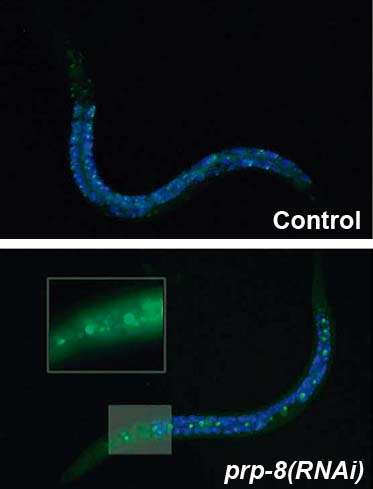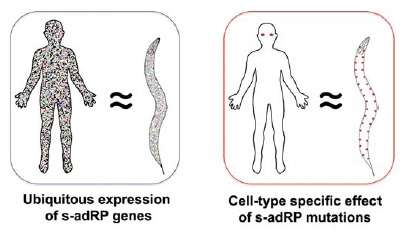Researchers create a worm model to investigate a rare subtype of blindness

Retinitis pigmentosa is a progressive blindness that affects more than one million people worldwide. A subtype of the disease is caused by mutations in genes that produce proteins responsible for maturation of RNA, known as "splicing."
Researchers of the group of human molecular genetics at the Bellvitge Biomedical Research Institute (IDIBELL), led by Julian Ceron, have created a model of the C. elegans worm with gene alterations homologous to human disease. Thus, this model opens up a promising avenue to understand the pathology and investigating new efficient therapies.
The study, funded by the La Marató de TV3 Foundation, has been published in the journal RNA.
Local mutations, overall pathology
Genes that produce "splicing" proteins are expressed in all body cells. However, mutations in these genes affect the retina where they produce cell death, but not in other tissues. It is a mystery that has not yet been resolved.
The study, conducted mainly by doctoral student Karinna Rubio and the researchers Laura Fontrodona and David Aristizabal, combines transcriptomics, genetics and cell biology to create a unique model in which to study Retinitis pigmentosa.
Researchers have found that inactivating the homologous genes that cause the disease in the worm C. elegans, the animal also has a cell death specifically in one cell type.
Furthermore, this study proposes a new hypothesis, based on genomic instability of the affected cells to explain the specificity of the disease in the retina.
Worms avatar

The investigator Julián Cerón says, "The group is currently working on C. elegans mutations that exist in patients. The great similarity of these genes in humans and worms allows using CRISPR to create an animal 'avatar' with the same mutation in the patient. C. elegans could become a platform on which to test drugs in a personalized way."
More information: Karinna Rubio-Peña et al. Modeling of autosomal-dominant retinitis pigmentosa in Caenorhabditis elegans uncovers a nexus between global impaired functioning of certain splicing factors and cell type-specific apoptosis, RNA (2015). DOI: 10.1261/rna.053397.115

















